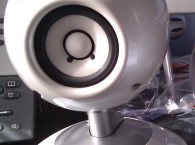
Jeong-Yun Sun (left) and Christoph Keplinger (right) demonstrate their transparent ionic speaker, which uses a signal conducted by ions rather than electrons to vibrate a rubber membrane. (Photo courtesy of Eliza Grinnell, SEAS Communications)
Researchers Jeong-Yun Sun and Christoph Keplinger at the Harvard School of Engineering and Applied Sciences (SEAS) have demonstrated a new type of loudspeaker transducer, which works on a different principle than the conventional moving coil design.
It is made of a thin sheet of transparent rubber sandwiched between two layers of salt-water gel. A modulated high-voltage signal passed across the two outer gel layers exerts pressure on the rubber membrane, causing it to vibrate and produce sound, much like a planar (or flat) speaker. According to the Harvard SEAS report, the prototype speaker has a 20-Hz-to-20-kHz frequency response.
The important thing is that the vibration effect is produced by the electrical charges carried by ions and not the movement of electrons. So strictly speaking, this is not an electronic device. And the speaker is clear as a window.
The high-voltage signal that runs across the surfaces and through the layers forces the transparent rubber to rapidly contract and vibrate, producing sound.
Published in Science’s August 30, 2013, issue, this new speaker represents the first demonstration that electrical charges carried by ions, rather than electrons, can be put to meaningful use in fast-moving, high-voltage devices.
“Ionic conductors could replace certain electronic systems; they even offer several advantages,” says co-lead author Sun, a postdoctoral fellow at Harvard SEAS.
For example, ionic conductors can be stretched to many times their normal area without an increase in resistivity—a problem common in stretchable electronic devices. Second, they can be transparent, making them well suited for optical applications. Third, the gels used as electrolytes are biocompatible, so it would be relatively easy to incorporate ionic devices (e.g., artificial muscles or skin) into biological systems or wearable devices.
According to Keplinger, who worked on the project as a postdoctoral fellow at Harvard SEAS and in the Department of Chemistry and Chemical Biology, such systems have great potential as sensors and for actuating automatically on movement, which opens a range of application possibilities.
The audio speaker represents a robust proof of concept for ionic conductors because producing sounds across the entire audible spectrum requires both high voltage (to squeeze hard on the rubber layer) and high-speed actuation (to vibrate quickly)—two criteria that are important for applications but would have ruled out the use of ionic conductors in the past.
The electrical connection to the power source is established outside the device’s active region where it does not need to be transparent. The traditional constraints are well known. High voltages can set off electrochemical reactions in ionic materials, producing gases and burning the materials. Ions are also much larger and heavier than electrons, so physically moving them through a circuit is typically slow.
The system invented at Harvard overcomes these problems. “It must seem counterintuitive to many people that ionic conductors could be used in a system that requires very fast actuation, like our speaker,” says Sun. “Yet by exploiting the rubber layer as an insulator, we’re able to control the voltage at the interfaces where the gel connects to the electrodes, so we don’t have to worry about unwanted chemical reactions. The input signal is an alternating current (AC), and we use the rubber sheet as a capacitor, which blocks the flow of charge carriers through the circuit. As a result, we don’t have to continuously move the ions in one direction, which would be slow. We simply redistribute them, which we can do thousands of times per second.”
According to Keplinger, “Our system doesn’t need a lot of power and you can integrate it anywhere you would need a soft, transparent layer that deforms in response to electrical stimuli (e.g., on the screen of a TV, laptop, or smartphone to generate sound or provide localized haptic feedback). People are even thinking about smart windows. You could potentially place this speaker on a window and achieve active noise cancellation with complete silence inside.”
The Harvard team chose to make its audio speaker out of simple materials. The electrolyte is a polyacrylamide gel swollen with salt water, but the team emphasized that an entire class of ionically conductive materials is available for experimentation. Future work will focus on identifying the best combinations of materials for compatibility, long life, and adhesion between the layers.
Harvard School of Engineering and Applied Sciences
www.seas.harvard.edu




